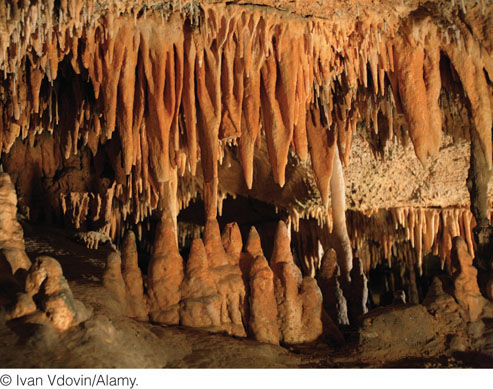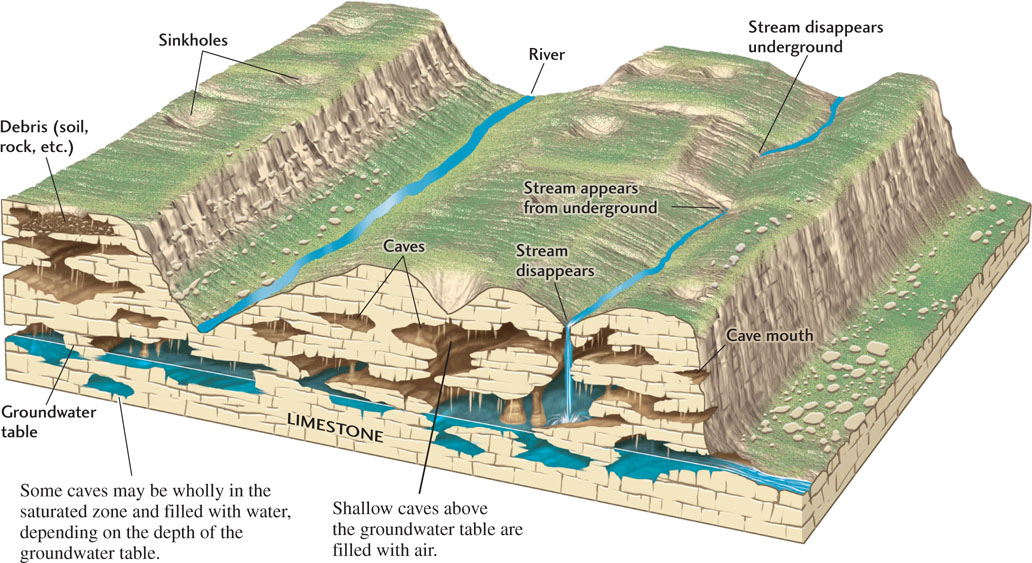Erosion by Groundwater
Every year, thousands of people visit caves, either on tours of popular attractions such as Mammoth Cave, Kentucky, or in adventurous explorations of little-known caves. These underground open spaces are actually enormous vugs produced by the dissolution of limestone—or, rarely, of other soluble rocks such as evaporites—by groundwater. Huge amounts of limestone have been dissolved to make some caves. Mammoth Cave, for example, has tens of kilometers of large and small interconnected chambers. The Big Room at Carlsbad Caverns, New Mexico, is more than 1200 m long, 200 m wide, and 100 m high.
Limestone is widespread in the upper parts of Earth’s crust, but caves form only where limestone is located at or near the ground surface and where enough carbon dioxide–rich or sulfur dioxide–rich water infiltrates the surface to dissolve extensive areas of this relatively soluble rock. As we saw in Chapter 16, atmospheric carbon dioxide dissolved in rainwater forms carbonic acid, which enhances the dissolution of limestone. Water that infiltrates soil may pick up even more carbon dioxide from plant roots, microorganisms, and other soil-dwelling organisms that give off this gas. As this carbon dioxide–rich water moves through the unsaturated zone to the saturated zone, it creates openings as it dissolves carbonate minerals. These openings are enlarged as the limestone dissolves along joints and fractures, forming a network of rooms and passages. Extensive cave networks form in the saturated zone, where—because the caves are filled with water—dissolution takes place over all surfaces, including floors, walls, and ceilings.
We can explore caves that were once below the water table but are now in the unsaturated zone because the water table has dropped. In these caves, now air-filled, water saturated with calcium carbonate may seep through the ceiling. As each drop of water drips from the cave’s ceiling, some of its dissolved carbon dioxide evaporates, escaping to the cave’s atmosphere. Its evaporation makes the calcium carbonate in the groundwater solution less soluble, so each water droplet precipitates a small amount of calcium carbonate on the ceiling. These deposits accumulate, just as an icicle grows, in a long, narrow spike of carbonate, called a stalactite, suspended from the ceiling. When the drop of water falls to the cave floor, more carbon dioxide escapes, and another small amount of calcium carbonate is precipitated on the floor below the stalactite. These deposits also accumulate, forming a stalagmite. Eventually, a stalactite and a stalagmite may grow together to form a column (Figure 17.19).

Microbial extremophiles (see Chapter 11) have been discovered living in caves, despite the lack of sunlight and highly acidic conditions that prevent most organisms from living in these environments. Some geologists think these microorganisms contributed to the formation of Carlsbad Caverns by using sulfates dissolved from gypsum (CaSO4) evaporites as an energy source and releasing sulfuric acid as a by-product. The sulfuric acid then helped to dissolve limestone to form the caves.
489
In some places, dissolution may thin the roof of a limestone cave so much that it collapses suddenly, producing a sinkhole: a small, steep depression in the land surface above the cave (Figure 17.20). Sinkholes are characteristic of a distinct type of topography known as karst, named for a region in the northern part of Slovenia. Karst topography is an irregular, hilly type of terrain characterized by sinkholes, caves, and a lack of surface streams (Figure 17.21). Underground drainage channels replace the normal surface drainage system of small and large streams. The short, scarce streams often end in sinkholes, detouring underground and sometimes reappearing miles away.


Karst topography is found in regions with three characteristics:
- 1. A humid climate with abundant vegetation (providing carbon dioxide–rich waters)
- 2. Extensively jointed limestone formations
- 3. Appreciable hydraulic gradients
In North and Central America, karst topography is found in limestone terrains of Indiana, Kentucky, and Florida and on the Yucatán Peninsula of Mexico. It is also well developed on uplifted coral limestone terrains formed from tropical island arcs in the late Cenozoic era.
Karst terrains often have environmental problems, including the potential for catastrophic cave-ins and surface subsidence due to the collapse of underground spaces. The spectacular tower karst of southeastern China formed when cave networks collapsed to form sinkholes, which then expanded and merged, leaving “towers” behind (Figure 17.22).

490